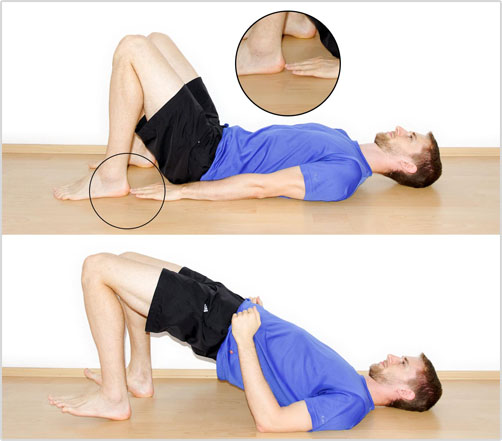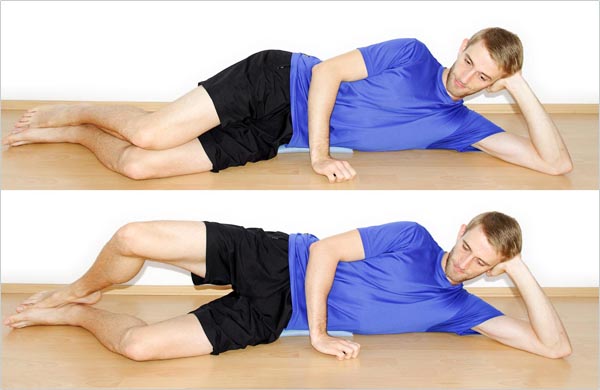Here’s a story I keep hearing from my readers. Maybe it happened to you as well.
Let’s say we have an imaginary friend called Michael. He went to physical therapy, because his knee hurt.
The therapist took Michael through a training program to build up his leg muscles for better “knee support,” but his pain never improved. Actually, it got worse and Michael stopped going to physical therapy altogether.
Too much is wrong with this conventional approach to cover everything in detail, so we’ll focus on the two main problems. They’re fascinating.
The first problem is that pain is the result of tissue damage inside the joint and most types of leg training will stop healing, by doing more tissue damage. It’s like trying to let your sunburn heal in the sun.
The second problem is that the conventional approach often confuses cause and effect. Let me explain.
Pain Shuts Muscles Down
The human brain wants to avoid pain whenever possible. That’s why we delay going to the dentist, but it’s also why muscles around a painful joint get weaker. The brain associates use of that muscle with pain, so it won’t let you create maximum muscle force.
If you don’t use a certain muscle, it will atrophy. That’s why the joint pain caused the muscle weakness and not vice versa. Trying to strengthen the weak muscle in the presence of pain will be an exercise in futility because the brain just won’t allow it to happen.
Now I hope you’re wondering what really caused the knee pain in the first place. That’s the Million Dollar question. Why did the tissues inside the knee become irritated?
I’m actually smiling and rubbing my hands as I’m writing this, because we’re now on the right track to help you heal.
In my research, I discovered more than a dozen hidden causes of knee pain. They can lead to years of pain, even though there’s no obvious connection to the knee. You won’t hear about them from your doctor or physical therapist, which is why I will share the full list in a future email.
Today, we’ll start working on the first item on that list. You probably won’t believe this has an impact, but wait until you’ve finished the email course. By working on this issue, you can strengthen your knees without any risk of setbacks, since you’re not working on the knee at all.
Do These Exercises to Strengthen Your Knees
These drills will make your knees more stable, because you’re strengthening hip muscles that control knee movement. Even better, by training these muscles, you will take stress off the knee by improving alignment, something we’ll cover in much more detail in a few days.
Exercise #1: Glute Bridges
The gluteus maximus is one of the largest and strongest muscles in the human body. It is very important for running, jumping, and many other movements that require hip extension.
However, many years of sitting will shut this muscle down neurologically, after which it quickly loses strength and size. The brain slowly “forgets” how to use the gluteus maximus.
A weak Gluteus Maximus can cause:
- Unattractive hips
- Hamstring tightness, as the hamstrings have to work harder to compensate
- More stress on the front of knee, as the body shifts weight towards your quadriceps muscles
- More tension on the knee in general, because of hamstring tightness
- Hamstring strains, as the hamstrings are overworked
- Lower back pain, since it’s not supported by the hip as well
The glute bridge will help you fix these problems. Here’s how you do it.

- Lie down on your back and place your arms at your side.
- Bring your heels close enough for your fingertips to touch them.
- Lift your hips by pushing through your heels.
- You can poke your buttocks muscles to help them contract.
- Push your hip as high as you can and hold for two seconds.
- DON’T push through your elbows.
- Come down, relax, and repeat.
Exercise #2: Hip Abductions
This seemingly simple exercise can be the key to resolving patellar tendonitis, patella-femoral pain syndrome, IT band syndrome, and a number of other knee diseases.
Here’s how you do hip abductions.

- Lie down on your side, with your body in a straight line.
- Keep the legs straight all the time.
- Lift the upper leg up by leading with the heel.
- Keep the heel pointed towards the ceiling.
- Lift the foot as high as you can and hold for two seconds.
- Come down, relax, and repeat.
Don’t worry if you don’t have a lot range of motion in the beginning. It will increase over time. Just make sure you feel the exercise in your hip and not in your thigh.
Exercise #3: Clamshells
Exercises #2 and #3 will allow you to keep your knees in healthy alignment even during challenging situations. The knee is merely slave to what happens at the hip and ankle, so we have to work on these areas before we can expect improvement at the knee.

- Lie down on your side with some padding under your hip.
- Bend your knees slightly and place them a bit in front of you.
- Rotate the upper leg up by using your hip muscles.
- Keep your feet relaxed throughout and don’t push off with the toes.
- Keep your upper body and your hip stationary, only move the working leg.
- Hold the elevated position for two seconds.
- Come down, relax, and repeat.
You should feel the exercise on the side of the hip.
Your Next Step…
Start your hip strengthening training right now by doing 15 repetitions of each exercise. Remember to do both sides. This will take less than 5 minutes and it will tell you a lot about your body.
I recommend you do it now.
– Martin Koban
PS: To learn more about why these exercises help prevent and heal knee pain, check out the following references or read this article.
Fukuda, Thiago Yukio; Melo, William Pagotti; Zaffalon, Bruno Marcos; Rossetto, Flavio Marcondes; Magalhães, Eduardo; Bryk, Flavio Fernandes; Martin, Robroy L. (2012): Hip posterolateral musculature strengthening in sedentary women with patellofemoral pain syndrome: a randomized controlled clinical trial with 1-year follow-up. In J Orthop Sports Phys Ther 42 (10), pp. 823-830.
Magalhães, Eduardo; Silva, Ana Paula M. C. C.; Sacramento, Sylvio N.; Martin, Robroy L.; Fukuda, Thiago Y. (2012): ISOMETRIC STRENGTH RATIOS OF THE HIP MUSCULATURE IN FEMALES WITH PATELLOFEMORAL PAIN: A COMPARISON TO PAINFREE CONTROLS. In J Strength Cond Res.
Meira, Erik P.; Brumitt, Jason (2011): Influence of the hip on patients with patellofemoral pain syndrome: a systematic review. In Sports Health 3 (5), pp. 455-465.
Negahban, Hossein; Etemadi, Malihe; Naghibi, Saeed; Emrani, Anita; Shaterzadeh Yazdi, Mohammad Jafar; Salehi, Reza; Moradi Bousari, Aida (2012): The effects of muscle fatigue on dynamic standing balance in people with and without patellofemoral pain syndrome. In Gait Posture.